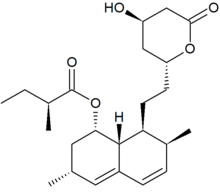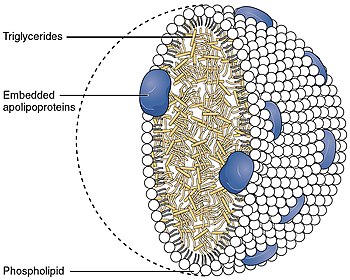
Lipidology is the scientific study of lipids. Lipids are a group of biological macromolecules that have a multitude of functions in the body. [1] [2] [3] Clinical studies on lipid metabolism in the body have led to developments in therapeutic lipidology for disorders such as cardiovascular disease. [4]
History
Compared to other biomedical fields, lipidology was long-neglected as the handling of oils, smears, and greases was unappealing to scientists and lipid separation was difficult. [5] It was not until 2002 that lipidomics, the study of lipid networks and their interaction with other molecules, appeared in the scientific literature. [6] Attention to the field was bolstered by the introduction of chromatography, spectrometry, and various forms of spectroscopy to the field, allowing lipids to be isolated and analyzed. [5] The field was further popularized following the cytologic application of the electron microscope, which led scientists to find that many metabolic pathways take place within, along, and through the cell membrane - the properties of which are strongly influenced by lipid composition. [5]
Clinical lipidology
The Framingham Heart Study and other epidemiological studies have found a correlation between lipoproteins and cardiovascular disease (CVD). [7] Lipoproteins are generally a major target of study in lipidology since lipids are transported throughout the body in the form of lipoproteins. [2]
A class of lipids known as phospholipids help make up what is known as lipoproteins, and a type of lipoprotein is called high density lipoprotein (HDL). [8] A high concentration of high density lipoproteins-cholesterols (HDL-C) have what is known as a vasoprotective effect on the body, a finding that correlates with an enhanced cardiovascular effect. [9] There is also a correlation between those with diseases such as chronic kidney disease, coronary artery disease, or diabetes mellitus and the possibility of low vasoprotective effect from HDL. [10]
Another factor of CVD that is often overlooked involves the concentrations of low-density lipoproteins (LDL) and very low-density lipoproteins (VLDL). These are often seen at higher than expected and necessary levels in the body due to food uptake, family history, and a person's metabolic rate. There is a correlation between these increased levels and stroke, heart attack, and mortality. [11]

Therapeutic lipidology
Statins are a class of drugs used to treat cardiovascular disease by lowering lipid levels, specifically LDL-C levels. [12] Statins have shown to reduce new cardiovascular events by 30-40%. [13] However, complications may still arise even after taking the drug and some patients are statin-intolerant. Lipoprotein apheresis therapy is another nonsurgical treatment for reducing LDL-C concentrations.
PCSK9 inhibitors are a new drug that can replace statins and lipoprotein apheresis therapy. [13] For patients that are statin-intolerant, PCSK9 inhibitors can provide a therapeutic alternative.
Lipidomics
Lipidomics is the complete profile of all lipids in a biological system at a given time. This is used to identify and quantify the lipids that can be detected. Since lipids have a variety of functions in the body, being able to understand which specific types are present in the body and at what levels is crucial to understand the diseases that result due to lipids. [14] Methods of lipidomic analysis include mass spectrometry and chromatography. [6] Monitoring lipid concentration can reveal much about an organism's health.
See also
References
- ^ Feingold, Kenneth R. (2000), Feingold, Kenneth R.; Anawalt, Bradley; Boyce, Alison; Chrousos, George (eds.), "Introduction to Lipids and Lipoproteins", Endotext, South Dartmouth (MA): MDText.com, Inc., PMID 26247089, retrieved 2022-08-25
- ^ a b Rusch, J A; Hudson, C L; Marais, A D (2018-03-28). "Laboratory investigations in lipidology". South African Medical Journal. 108 (4): 266. doi: 10.7196/samj.2017.v108i4.13233. ISSN 2078-5135.
- ^ Lim, Seon Ah; Su, Wei; Chapman, Nicole M.; Chi, Hongbo (May 2022). "Lipid metabolism in T cell signaling and function". Nature Chemical Biology. 18 (5): 470–481. doi: 10.1038/s41589-022-01017-3. ISSN 1552-4469. PMID 35484263. S2CID 248423097.
- ^ Michos, Erin D.; McEvoy, John W.; Blumenthal, Roger S. (2019-10-17). Jarcho, John A. (ed.). "Lipid Management for the Prevention of Atherosclerotic Cardiovascular Disease". New England Journal of Medicine. 381 (16): 1557–1567. doi: 10.1056/NEJMra1806939. ISSN 0028-4793. PMID 31618541. S2CID 204756336.
- ^ a b c Kates 1972, p. 275-276.
- ^ a b Holčapek, Michal (July 2015). "Lipidomics". Analytical and Bioanalytical Chemistry. 407 (17): 4971–4972. doi: 10.1007/s00216-015-8740-0. ISSN 1618-2642. PMID 25963650.
- ^ Therapeutic lipidology, p. vii-viii
- ^ Feingold, Kenneth R.; Grunfeld, Carl (2000), De Groot, Leslie J.; Chrousos, George; Dungan, Kathleen; Feingold, Kenneth R. (eds.), "Introduction to Lipids and Lipoproteins", Endotext, MDText.com, Inc., PMID 26247089, retrieved 2018-12-14
- ^ Speer, Thimoteus; Meinitzer, Andreas; März, Winfried; Fliser, Danilo; Lüscher, Thomas F.; Landmesser, Ulf; von Eckardstein, Arnold; Laufs, Ulrich; Böger, Rainer H. (2017-05-21). "Symmetric dimethylarginine, high-density lipoproteins and cardiovascular disease". European Heart Journal. 38 (20): 1597–1607. doi: 10.1093/eurheartj/ehx118. ISSN 0195-668X. PMID 28379378.
- ^ Bell, David S.H. (October 1996). "Diabetes mellitus and coronary artery disease". Coronary Artery Disease. 7 (10): 715–722. doi: 10.1097/00019501-199610000-00004. ISSN 0954-6928. PMID 8970762.
- ^ Brown, William Virgil (2018-07-12). "Clinical Lipidology and the Prevention of Vascular Disease: Time for Personalized Therapy". Clinical Pharmacology & Therapeutics. 104 (2): 269–281. doi: 10.1002/cpt.1127. ISSN 0009-9236. PMID 29998536. S2CID 51621704.
- ^ Davidson, Michael H. (2007), Davidson, Michael H.; Toth, Peter P.; Maki, Kevin C.; Gotto, Antonio M. (eds.), "Pharmacological Therapy for Cardiovascular Disease", Therapeutic Lipidology, Totowa, NJ: Humana Press, pp. 121–148, doi: 10.1007/978-1-59745-533-6_7, ISBN 978-1-59745-533-6, retrieved 2022-05-12
- ^ a b Julius, Ulrich (November 2017). "History of lipidology and lipoprotein apheresis". Atherosclerosis Supplements. 30: 1–8. doi: 10.1016/j.atherosclerosissup.2017.05.034. PMID 29096824.
- ^ Postle, Anthony D. (2012). "Lipidomics". Current Opinion in Clinical Nutrition and Metabolic Care. 15 (2): 127–133. doi: 10.1097/MCO.0b013e32834fb003. ISSN 1363-1950. PMID 22316558. S2CID 220586183.
- Books
- Kates, Morris (1972), Techniques of lipidology; isolation, analysis and identification of lipids, Laboratory Techniques in Biochemistry and Molecular Biology, vol. 3, Amsterdam, New York: North-Holland Pub. Co.American Elsevier, pp. 269–610, doi: 10.1016/S0075-7535(08)70544-8, ISBN 978-0444103505
- Therapeutic lipidology. Totowa, N.J.: Humana. 2007. ISBN 9781597455336.

